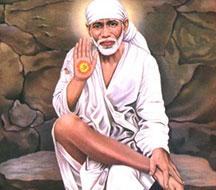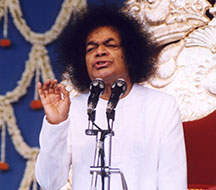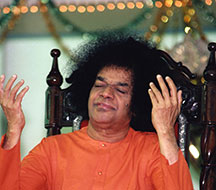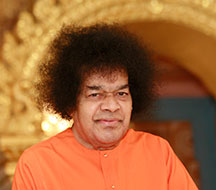
Everything is present in Vedas
Puttaparthi, Sai Kulwanth Hall (1996 Special Discourses )
Description
“Sahana vavathu, sahanau bhunaktu, sahaveeryam karavavahai,” All should be united. Kalasi melasi tirugudaam, Kalasimelasi perugudaam, Kalasimelasi telusukonna telivini poshinchudaam, Kalasimelasi kalatha leka Chelimi to jeevinchudaam, Let us move together, Let us grow together, Let us develop the knowledge together, Let us live in friendship, without any differences!! It was the Vedas that first taught unity and oneness. Vedas are being treated as useless because of the lack people who can teach it correctly. It is being treated as rituals, full of mantras to be chanted. No. It is not correct. Vedas are the source ofall the mighty power. Everything is contained in Vedas and everything originates from Vedas. Vedas supply knowledge to all nations. Knowledge of all the modern weaponry is from Vedas, mainly the Atharvana Veda but Bharathiyas are unable to recognize this fact. Bharath was the leader of all nations. But the great examples of those days are becoming extinct now. Thereby students are not able to have belief in those truths.
Topics
-Vedas
-
_1441086525.jpg)
Where Vedas end, Vedanta begins, explanation of Vedanta
00:07:23Therefore Vedas are limited to the physical world. Next is the ‘Vedantam’, which is most important. For the spiritual path, this is the true beginning and the true goal. The beginning and the end are one and the same. It is very difficult to know the different levels prescribed by the Vedantam. Hence the whole of Vedantam has been summed up into three aspects. Students must listen very carefully as it is essential to know about these three important aspects. The most important and the one that needs to be known are these three aspects. The first one is the ‘Tarakam’. The second one is ‘Sankhyam’ and third one is ‘Amanaskam’. These three are the end and essence of Vedanta. What is meant by ‘Tarakam’? It is ‘Khechari’, ‘Vechari’, ‘Madhyama’ and the true essence ‘Bhagawati’. One must try to analyse the essence of these four aspects. What is the meaning of ‘Tarakam’? Many people have described it in many ways. There are five signs in this. One should know clearly the five signs, ‘Pancha Mudras’. One should know these five signs, research and investigate them properly, experience them, then determine the necessary and the unnecessary and brush aside the unnecessary; have a vision of nadabindu and realise the ‘Hamsatwa’, later on experience the state of Sath-Chit-Ananda on earth—this sums up ‘Tarakam’. Immersing and concentrating the human mind in the principle of sath-chit-ananda, the ultimate bliss is called as ‘Tarakam’. The second one is ‘Sankhyamu’. It refers to the ‘Panchendriya’, the five senses, ‘Pancha prana’ the five life breaths, ‘Pancha bhoota’ ,the five elements , ‘Pancha kosamu’ the five life sheaths, the mind, ‘Chittamu’- intellect, ‘Antahkarana’- conscience, jeevamu -the in-dweller- these twenty five aspects. Then one must properly investigate and research each aspect to know the real ‘I’. Investigation and enquiry must lead one to know that none of them is the real “I”. Believing that none of the aspects help in knowing the real principle of one self- the Atma, one must realise that the principle of atma is the Sat-Chit-Ananda which is beyond enquiry and beyond the transcendental. Ultimately one realises that the sath-chit-ananda is atma and that one is atma, and realises the total identification of the “I” with the Atma. This is called as ‘Sankhya yoga’. It involves a thorough enquiry of the inner as well as the outer senses. Next is the ‘Amanaskamu’. What is the meaning of ‘Amanaskam’? The thing that is seen with the help of the five elements, the entire physical world, is the manifestation of the inner vision. The entire existence is nothing but the Brahman for there exists none other than that, “yekam yeva adviteeyam Brahma”, there is only one, the magnificent Brahma. The entire creation is Brahma. There is no second entity. In that scenario, the mind that thinks, too, does not exist. The vastness of the creation is visible only when there are thoughts and counter thoughts. Without the vastness when everything exists as single entity, the mind ceases to exist. Whatever one sees is Brahman, whatever one listens is Brahman, whatever one thinks is Brahman, whatever one utters is Brahman, and whatever one does is Brahman and wherever one walks is Brahman. Therefore when everything is Brahman, there is no mind. The thoughts and counter thoughts occur only when there is a second entity. Since there is no scope for thoughts, it is called as ‘Amanaskamu’, the state of retraction of mind. In that state love alone exists. That love is the truth. Truth and love are one and the same.
-

Vedas classified into three Samhithas
00:05:59However, all the Vedas pertain to the physical world and its affairs. Further each Veda is divided into three Samhithas. In Samhitha there are three parts again namely: ‘Braahmanamu’, ‘Aranyakamu’ and ‘Upanishad’. The Brahmanamu is full of mantras which are useful in performing Yagna, Yaga and other auspicious rituals and thereby deriving well-being of all. Aranyakamu refers to the study of Veda by the householder in the later stages of life, called as ‘Vanaprastham’. In the Vanaprastham stage the householder dwells in the forest along with his wife and studies the Veda, hence, the name ‘Aranyakamu’. The Vanaprastham stage is full of austerities. Vanaprastham precedes the Sanyasa stage. It is possible to lead the Sanyasa path correctly only when one’s conduct and behaviour in Vanaprastham is proper. Both husband and wife must leave the home and travel northwards in the forest. Leaving their home, the wife and husband, must travel northwards till their death. They must not live in places which have walls or the roof. The life of Vanaprastha is that of continuing on the chosen path in spite of being exposed to rain and sun. The wife and the husband lead the life in the forest as brother and sister. Commencing from the full moon day they must gradually cut down the food intake morsel by morsel. By the new moon day they must stop taking food altogether. From new moon day onwards they must increase their food intake morsel by morsel and by full moon day they must stop food intake. If any kind householder wants to serve food to the Vanaprastha, it must not be served in plates. The Vanaprastha should not dine in other’s homes. They must take the food on a leaf, eat it outside and discard the leaf. The people leading the life of Vanaprastha stage observed such severe and strict austerities. All the actions pertaining to the four different stages namely bramacharyamu, gruhasthashramam, Vanaprastham and sanyasam, are absolutely worldly. All these are prescribed to control the mind and so they are not the acts that would make one eligible to enjoy the manifestation of the Lord. It is not the objective of the objectives of life that is the Supreme, ‘Parabhatti’. Therefore Vedas are limited to the physical world. Next is the ‘Vedantam’, which is most important. For the spiritual path this is the true beginning and the true goal. The beginning and the end are one and the same.
-

What are Vedas, their origin and significance
00:09:19Embodiments of Divine atma!! From ancient times the people of Bharath have gone through sacred texts like Vedas in pursuit of the primary objectives of life viz., ‘Dharma, Artha, Kama, Moksha’ (righteousness, wealth, desire and liberation). ‘Veda’ is the expression of truth experienced by seers and saints of ancient times. Veda originates from the root word ‘vid’. Veda means wisdom. Veda speaks about human welfare and divine life in three phases of time and in all the three worlds. It propounds that the worldly life can be made a purposeful life through worldly actions. Vedas pertain to ‘avidya’ and refers to the doctrine of ‘dwaitha’ dualism. The reason being that basing on divinity it preaches the humanity, the daily routine and rituals in pursuit of objectives of life viz., Dharma, Artha, Kama, Moksha. In the beginning the Veda was one only. “Anantho vai vedaha” Veda is vast, limitless. Veda is one. In the ancient times, only the sages could study such vast Veda and passed it to next generation through the guru-shishya tradition. The human population in those days was limited. The Veda which is one, vast and which teaches important divine ideals to mankind, in due course of time was divided into three. The three Veda are: the Rig Veda, yajur Veda and the Sama Veda. Later the Yajur Veda was divided into two – Sukla Yajur Veda and Krishna Yajur Veda. After this came the fourth Veda- Atharvana Veda. Therefore, in the world today, based on what is taught and practised, there exists five Vedas: Rig Veda, Yajur Veda, Sama Veda, Atharvana Veda and part of Yajur Veda that is Sukla Yajur Veda. Veda has nine names. The first one is ‘Sruthi’. In those times there was no paper or printing or books. Education was through the tradition of guru- shishya, by way of listening alone. Hence it is called as ‘Sravanam’. That which is learnt by listening is called as “Sruthi”. The second name of Veda is: “AnuSravanam”. The third one is “Aamnyaam”. The fourth is, “Samaanyayam”. Fifth one “Chandassu”, sixth one “Adhyaasa”, seventh one “Gamanam”, eighth one “Nigamagamam”. The eighth one made up of “nigama” and “aagama”. So all together nine names. “Nigamagamam” means inhalation and exhalation. Hence the inhaling and exhaling of the Lord is termed as “Nigamagamam”. However, all the Vedas pertain to the physical world and its affairs. Further each Veda is divided into three Samhithas. In Samhitha there are three parts again namely: ‘Braahmanamu’, ‘Aranyakamu’ and ‘Upanishad’. The Braahmanamu is full of mantras that are useful in performing yagna, yaaga (sacrificial rituals) and other auspicious rituals which, thereby, provide the well- being of all. Aranyakamu refers to the study of Veda by the householder in the later stage of life, which is called as ‘Vanaprastham’. In the Vanaprastham stage the householder dwells in the forest along with his wife and studies the Veda, hence, the name ‘Aranyakamu’. The Vanaprastham stage is full of austerities. Vanaprastham precedes the Sanyasa stage. It is possible to lead the Sanyasa path correctly only when one’s conduct and behaviour in Vanaprastham is proper. Both husband and wife must leave the home.
-

Vedas first proclaimed the importance of peace and unity
00:01:27“Shantamu leka saukhyamu ledu Sarasadala nayana! Without peace there is no prosperity O lotus eyed one!!” Without peace there can no happiness. Who needs peace? Be it one who has mastered the senses or a philosopher, be it a slave of senses or master of senses- they must have peace. Vedas taught such peace. Vedas propagate unity. But the pundits, the learned today are not trying to teach these secrets of Vedas. It is not their fault too for they themselves do not know about it. The vedas begin first and foremost with concept of unity. “Sahanavavatu, sahanubhunakthu, sahaveeryam karavaavahi,” everyone must live in together and in harmony. That is expressed as: “Kalasi melasi melugudaam, Kalasi melasi tirugudaam Kalasi melasi telusukonna Telivini poshinchukundaam!!” Lets us live together, Let us move together, Let us mutually share the knowledge Kalasi melasi kalatha leka Chelimitho jeevinchudaam Let us dwell together Without any conflicts!! This is the foremost teaching of Vedas.
-

Veda is Dwaitha
00:01:52Based on the nature of the world, the four Vedas declare the four great sayings: “Aham Brahmasmi, Pragnyanam Brahma, Ayamatma Brahma, Tat twam Asi”. The entire Veda is dualism. Where can one find ‘adwaitha’, non-dualism, when the Vedas themselves are ‘dwaitha’, dualism? Vedas were formed to guide man to choose the right wants, right experiences, and the right path to happiness. The Vedas also set the code of conduct for the different stages of life viz. ‘brahmachari’ the celibate, ‘gruhastha’ the householder, ‘vaanaprastha’ the old age, ‘sanyasi’ the recluse. Vedas teach the code of conduct but is dualism. Vedanta is adwaitha, non-dualism which is the Upanishad. The Vedanta too negates the dualism. In the statement, ‘Aham Brahmasmi’, I am Brahma, there are two entities ‘I” and “brahma’. When there are two entities it amounts to dualism and not to non- dualism. In this way one can understand that divinity is everywhere, but due to ignorance man is unable to know the truth and is subjected to many troubles and sufferings.
-

Inner significance of Vedas
00:01:41And we find that this is Dharma - the code we read, and they all speak of same divinity. Vedas refer to four mahavakya.'Tat Tvam Asi' ' That Thou Art' and how many people follow that? 'Pragnanam Brahma' that means 'Awarenesss is Divine'. Constant integrated awareness. That awareness, constant integrated awareness. Only one that exists. What is it? Truth is one. The third one, 'Ayam Atma Brahma', in english you can say "I am Atma and Brahma". I am Atma. I am Brahma. That is Ayam Atma Brahma. Vedas refer to such subtle meanings. We just repeat like a parrot all these dicta. We just utter but we don't follow. We don't practice. All that you do not practice all utterances are false and only pomp and show.
-

Through vedas one can attain Brahmanatwa and Brahmatattwa
00:01:40One attains the third life when one chants the Vedas. He is then called a ‘Viprudu’. When this is considered as the third birth, one must follow the path of gradual study of vedas, knowing the significance of the mantras therein and lead one’s life in accordance with the said principles. By studying the vedas one would succeed in attaining ‘Brahma’. It is only when one acquires the state of ‘brahma’ that one can be called a ‘Brahmana’. It is very important that one is a Brahmana not only by virtue of his birth but also by virtue one’s actions. One should also realise and continue to realise the truth that being called a Brahmana by virtue of birth and actions is truly the path to the Divinity. Therefore, it is not proper to state one as a Brahmana by virtue of birth. One is qualified to be called a Brahmana only when one has understood and attained the state of Brahma.
-

Vedas propounds unity
00:01:58The Veda in Bharatheeya culture is most important and is held as the standard. The whole world is full of infinite number of heads, innumerable number of hands and feet. Therefore we should live together. We should move about together. We should also improve upon the intelligence that we have come to know. We should live in friendship without any conflicts or differences of opinion. This is the main teaching of Veda. All should live together. Unity is human life. One should practice for progress. But today there is no unity. Because of the absence of unity, human life has lost its meaning. When you increase in unity, purity will develop. When purity develops, you will have divinity. When there is no unity, enmity based on community steps in. So don’t give scope for enmity. That’s our enemy. Mankind has 3 enemies – they are desire, anger and hatred. These are demons. Don’t entertain them.
Topics
- Analogies
- Atma
- Attachment
- Balvikas
- Bhaja Govindam
- Bhajans
- Body
- Character
- Company
- Compassion
- Culture
- Day to day
- Desire
- Devotees
- Devotion
- Dharma
- Discipline
- Discrimination
- Doctors
- Education
- Faith
- Festivals
- Forbearance
- Gayathri
- God
- Gratitude
- Guru
- Health and healthcare
- HIS Life
- Human values
- India
- Karma
- Love
- Mahabharata
- Man
- Meditation
- Mind
- Music
- Musicians
- Namasmarana
- Nature
- Parents
- Philosophical concepts
- Pleasure and Pain
- Practice
- Ramayana
- Religion
- Sacrifice
- Sadhana
- Sai Organization
- Saints
- Sathya
- Science
- Senses
- Service
- Sevadal
- Shanthi
- Shirdi Baba
- Society
- Spirituality
- Students
- Thoughts
- Time
- Unity
- Upanishad
- Vices
- Yoga
- Youth
